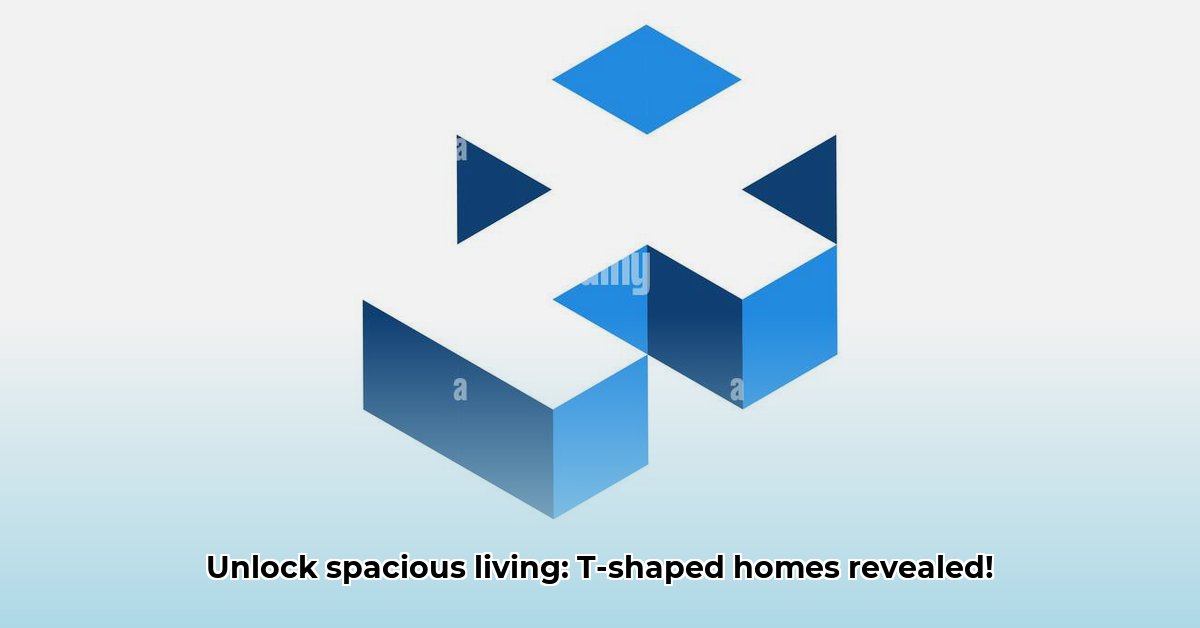Thinking about building or renovating and aiming for a design that’s both beautiful and practical? T-shaped house plans are gaining traction, and for good reason. It’s a smart design maximizing space and light. This article explores everything you need to know about T-shaped floor plans, compares them to traditional layouts, and offers actionable tips to tailor your T-shaped home to your lifestyle and budget. For more open-plan ideas, check out open floor plans.
T-shaped Floor Plan: Maximize Light, Space, and Functionality
The T-shaped floor plan is a clever design solution blending style and functionality, maximizing natural light and usable living space. Let’s explore why this layout is making waves in home design.
Unveiling the “T”: A Design Decoded for Modern Living
The T-shaped plan resembles a capital ‘T,’ featuring a main rectangular section with a perpendicular wing extending from one side. This creates distinct zones, offering a balance between open living and private retreats, adapting to various architectural styles from rustic to modern. Its versatility extends to different lot sizes and orientations, suitable for cottages and modern masterpieces alike.
Architects often utilize the T-shape to optimize solar exposure, placing living areas to capture sunlight and bedrooms in more private, shaded wings. This layout also lends itself well to creating a courtyard effect, sheltering outdoor spaces from wind and providing a sense of enclosure
The Bright Side: Advantages of Choosing a T-Shape for Sunlight and Space
A thoughtfully designed T-shaped home offers numerous benefits.
- Sunlight Symphony: Extended wings allow strategic window placement, creating a sunlit space and lowering energy bills for a cheerful atmosphere. Fewer artificial lights result in an energy-efficient home. The T-shape’s configuration allows for capturing morning and afternoon light, optimizing natural illumination throughout the day.
- Smart Space Usage: The design maximizes space, creating defined living zones without feeling cramped, offering openness with desired privacy. The T-shape excels at efficient space utilization. For example, the main section can house communal areas like the living room and kitchen, while the wing accommodates bedrooms and bathrooms.
- Style Versatility: The T-shape adapts beautifully to diverse architectural styles, whether a rustic farmhouse, minimalist modern dwelling, or traditional colonial. The shape lends itself to both symmetrical and asymmetrical designs, offering further flexibility.
- Private Havens: Enhanced privacy is a key benefit, with bedrooms and private spaces tucked away in the wings, creating a peaceful retreat from main living areas. This separation is ideal for families with varying schedules or those who enjoy dedicated quiet zones.
- Effortless Flow: The design facilitates a smooth flow between living areas, perfect for entertaining or enjoying movement throughout the home. This open flow can be enhanced by features such as wide doorways and consistent flooring materials.
Things to Consider: Potential Challenges in T-Shape Designs
While the T-shape offers advantages, consider potential drawbacks.
- Construction Costs: Costs might exceed simpler layouts due to additional framing and roofing, necessitating detailed planning and budgeting. The increased perimeter can also lead to higher foundation costs.
- Lot Compatibility: Careful consideration of lot size, shape, and orientation is crucial. Optimal positioning maximizes sunlight and views, requiring consultation with a skilled architect. Irregularly shaped lots may present challenges in adapting the T-shape effectively.
- Privacy Considerations: Specific room placement is crucial to avoid overlooking rooms and ensuring intended privacy. Consider window placement and landscaping to maintain desired seclusion. Proper window treatments are important.
Visualizing Your Dream Home: Inspiration and Examples of T-Shaped Designs
A well-executed T-shaped design promises sunlight streaming through windows and gentle breezes, browsing online resources and exploring various floor plans to find examples that resonate with your personal style and living needs. Before-and-after photos of similar projects can highlight the transformation achieved. Look for examples that showcase both interior and exterior design elements.
Making the T-Shape Work for You: Key Questions to Ask Before You Build
Before committing to a T-shaped floor plan, ask yourself these questions:
- Lifestyle Audit: Does this design truly complement your lifestyle? A T-shaped design offers great flexibility, it’s essential to ensure it accommodates your specific needs. Consider your daily routines, entertaining habits, and long-term goals.
- Lot Assessment: Is your property suitable for a T-shaped house? Work closely with an architect and a surveyor to determine the optimal placement and orientation of the house on your land. Soil conditions, drainage patterns, and potential easements should also be evaluated.
- Budget Reality Check: Be realistic about your budget, remembering to incorporate potential construction cost increases associated with this design into your financial plan. Obtain multiple quotes from qualified contractors and factor in contingency funds for unexpected expenses.
Your Next Steps: From Dream Home Vision to Reality
Start by exploring available T-shaped house plans online, schedule a consultation with a skilled architect to customize a design reflecting your needs, preferences, and budget. With planning and a collaborative approach, your dream T-shaped home can become a reality.
How to Maximize Natural Light in a T-Shaped House Design – Expert Tips
Key Takeaways:
- T-shaped homes offer unique opportunities for maximizing natural light due to their multi-faceted design.
- Strategic window placement is crucial for harnessing sunlight throughout the day.
- Careful consideration of the home’s orientation relative to the sun is paramount.
- Interior design choices can amplify natural light’s impact.
- Utilizing light-colored paints and reflective surfaces enhances brightness.
Understanding the T-Shaped Advantage For Light
The beauty of a T-shaped home lies in its ability to capture light, offering numerous opportunities for windows on multiple sides. The focus is on thoughtful planning rather than just the shape itself. The T-shape allows for distinct zones with varying light exposure, creating dynamic spaces throughout the day.
Strategic Window Placement: The Cornerstone of Bright Living – Energy Efficient Design
Maximize natural light by placing large windows on both sides of the “stem” to allow sunlight to penetrate the house. The “crossbar” can benefit from multiple window placements angled to catch different sun angles, while avoiding blocking windows with furniture or curtains. Consider incorporating clerestory windows (high, horizontal windows) to bounce light deep into the interior.
Orientation Matters: Harnessing the Sun’s Power Throughout the Day
Before construction, work with your architect to determine optimal orientation, maximizing winter sun with south-facing windows (Northern Hemisphere) and using overhangs to protect against summer heat. In the Southern Hemisphere, north-facing windows are ideal. Use software to model the sun’s path throughout the year and optimize window placement accordingly.
Interior Design: Amplifying the Light From Your Windows
Light-colored walls and ceilings reflect light, bouncing it around rooms. Use mirrors strategically and avoid dark furniture that absorbs light. Consider using semi-gloss or gloss paint finishes to further enhance light reflection.
Beyond the Basics: Skylights and Atriums for Enhanced Natural Lighting Solutions
Skylights bring light directly into the home’s center, illuminating darker areas. For high ceilings, atriums can significantly improve lighting and ventilation, creating light-filled spaces. Solatubes, or tubular skylights, can also be used to channel light into smaller spaces.
Case Study: A Modern T-Shaped Home and Natural Light
One successful design strategically placed large windows on both sides of a central hallway, allowing light to flow through to adjacent rooms. Skylights over the stairwell further enhanced natural light, creating a bright atmosphere. This demonstrates how a thoughtful combination of window placement and skylights can transform a space.
Pros and Cons of T-Shaped Homes Related to Natural Light
| Pros | Cons |
|---|---|
| Excellent natural light potential | Complex roofline, potentially increasing costs |
| Efficient separation of living areas | Requires careful planning for optimal orientation |
| Adaptable to various architectural styles | May not be suitable for all lot shapes or sizes |
T-Shaped Floor Plans for Narrow Lots: Maximizing Space and Light On A Budget
Key Takeaways:
- T-shaped homes cleverly use space, especially on narrow lots.
- Their design maximizes natural light.
- They often separate public and private areas effectively.
- Successful design relies on smart site orientation and interior planning.
- Potential drawbacks include increased building costs and the need for skillful planning to prevent awkward layouts.
Why Choose a T-Shaped Home For A Narrow Lot?
A T-shaped house offers spaciousness and sun-drenched interiors, even on a narrow lot, creating opportunities for maximizing light and optimizing space flow. The extended wing allows increased window placement, bathing the interior in sunlight. This design is particularly effective when the longer part of the “T” runs parallel to the longest dimension of the lot.
Light and Space: A Winning Combination – Energy Efficiency
The elongated design invites light, with the extended “arm” offering ideal placement for expansive windows, creating openness. This layout efficiently uses available square footage, allowing for a flexible and functional arrangement of rooms. Consider using open floor plans to maximize light penetration and create a more spacious feel.
Design Considerations: Optimizing The Design of Your T-Shaped Home
Consider site orientation for maximizing sunlight and breezes, along with careful planning of the interior layout for smooth room flow. Proper positioning of hallways and staircases will prevent dead ends, while ensuring ample storage is integrated into the design. Use vertical space
- Gray Kitchen Backsplash Ideas: Find Your Perfect Gray Tile - December 11, 2025
- Glass Wall Tiles For Bathroom: A Stylish, Durable Choice - December 10, 2025
- Glass Mosaic Kitchen Backsplash: Add Shimmer and Style - December 9, 2025









